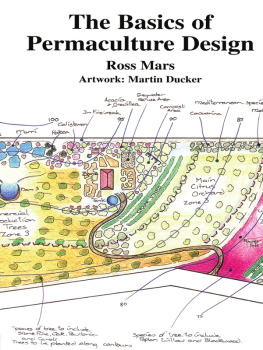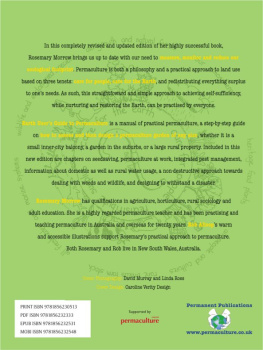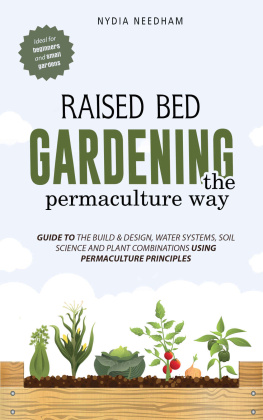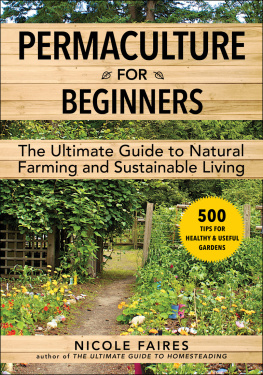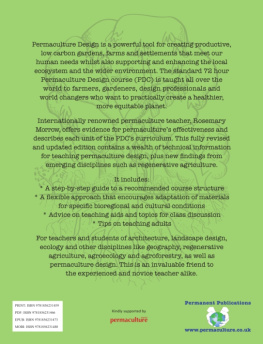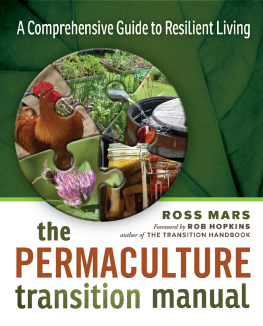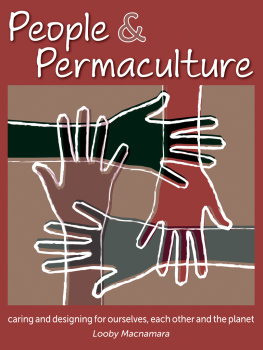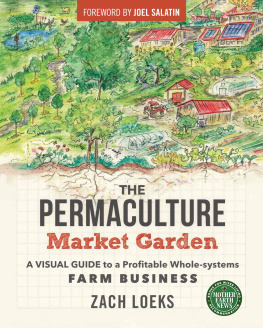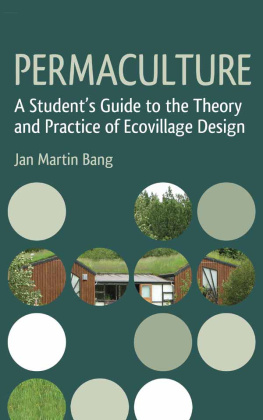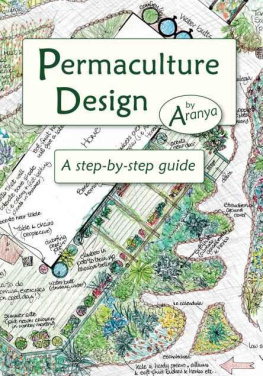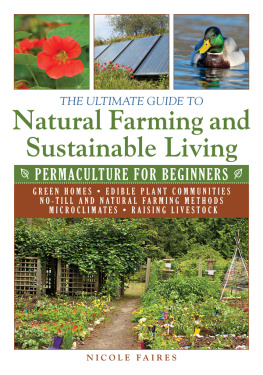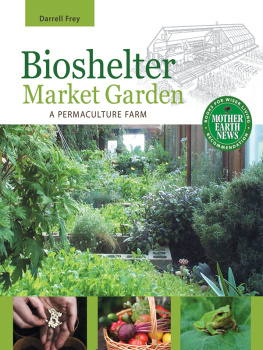
The Basics of Permaculture Design
Ross Mars
Artwork by
Martin Ducker
CHELSEA GREEN PUBLISHING COMPANY
White River Junction, Vermont
A Permanent Publications Book
Published by:
Permanent Publications
Hyden House Ltd.
The Sustainability Centre, East Meon, Hampshire GU32 1HR, UK
Tel: (01730) 823 311
Fax: (01730) 823 322
Email: enquiries@permaculture.co.uk
Web:www.permaculture.co.uk
Published in the United States in 2005
by Chelsea Green Publishing Company
www.chelseagreen.com
Published in 2003
by Permanent Publications, UK
First Published 1996
by Candlelight Trust, W.A., Australia
1996 Candlelight Trust, W.A., Australia
Artwork by Martin Ducker
Typesetting and layout by Ross Mars
British Library Cataloguing in-Publication Data
A catalogue record for this book is available from the British Library.
eBook ISBN: 978-1-60358-125-7
All rights reserved. Apart from any fair dealing for the purpose of study, research, criticism or review, as permitted under the Copyright Act, no part of this publication may be reproduced, stored in a retrieval system, rebound or transmitted in any form or by any means, electronic, mechanical, photocopying, recording or otherwise, without the prior written permission of Ross Mars, Hyden House Limited or Chelsea Green Publishing Company.
Acknowledgements
A sincere thank you goes to the following people who have commented on various chapters of this book and made valuable contributions to its production:
Graham Bell, Peter Bennett, Dora Byrne, David Coleman, Naomi Coleman, Peter Cuming, Chris Dixon, Martin Ducker, Calen Feorn, Pratibodha Foreman, David Holmgren, Max Lindegger, Jeff Nugent, Peter Pedals, Salli Ramsden, Margaret Sampey, Pat Scott, Reny Mia Sley, Russell Turner, Patrick Whitefield, Julie Woodman, Peter Woodward.
A special thank you to Barbara Sheppard and Bob Gehringer for permission to use the design of their Donnybrook property for the cover.
by David Holmgren
The permaculture concept, developed by Bill Mollison and myself in the mid 70s, is the conscious design of our working relationship with nature. Further development, application and extension to a wider public have resulted in an explosive growth towards a worldwide network of activity and influence.
Many would see this growth as part of a fad and fashion element in the global village. Others see it as the result of Mollisons personal energy and charisma. While these factors are undoubtedly elements in the growth of permaculture over the last twenty years, in the absence of any organisational structure and management for growth, it is reasonable to suggest that permaculture does provide some of the conceptual links and practical solutions needed to re-establish our working relationship with nature.
It is now widely accepted, almost to the level of cliche, that design is the central organising skill of the post-industrial revolution. That enough basic knowledge exists, but that this knowledge is theoretical and divided into specialist disciplines rather than being practical and integrated, is increasingly understood.
Permaculture involves the integration of ecological design principles, the ethics and values of working with nature and the detailed situation and site-specific practical realities of life. In trying to combine these three very different spheres of human activity, there is constant tension and the need to re-assert balance.
In The Basics of Permaculture Design we see the results of one experienced permaculture practitioner, designer and teachers efforts to maintain this balance. Ross Mars has written a clear and readable guide to permaculture design. The personal experience in dealing with the realities of the affluent society and the West Australian environment come through as hallmarks of practical knowledge, while the design process orientation and frequent examples provide a link to a wider readership.
The mass solutions in land use, livelihoods and language of our industrial culture have failed us. The hope and search for new mass solutions contradicts the site and situation specific characteristics of nature. What we need are universal, powerful and comprehensible design principles for guiding practical and diverse development.
This is the holy grail of permaculture which needs ongoing effort and focus. However, in life, we always lack complete understanding and yet, we must act. Ross Mars has provided a useful tool for effective action now.
David Holmgren, Hepburn. August 1996
Contents
by David Holmgren
Permaculture deals with our existence on this planet and it encompasses many different aspects of this. Firstly, permaculture is about producing edible landscapes, mirroring the natural ecosystems in their diversity and production. Permaculture is primarily a design system. This is the main difference between it and all other agricultural and horticultural practices. Permaculture designs endeavour to integrate all components of the ecosystem in a holistic approach to sustainable living and practice.
Permaculture started out as permanent agriculture and thus focussed on the growth and development of perennial food crops. Annuals and biennials do have their place, but the use of long-livingfood crops, such as fruit and nut trees, is the priority. Some areas of the garden need to be devoted to annuals and in most cases they can be interplanted between the perennial herbs and other trees as companion planted guilds. Too often, annuals are taken for granted in food production and they should be used in the system within the framework of perennial production.

Figure 1.1 A garden should have diversity of annuals and perennials.
Permaculture is not just about gardening, although its origin of permanent agriculture suggests this. Nowadays, permaculture is thought of along the lines of permanent culture, incorporating all aspects of human beings and human settlements.
Gardening, however, is one simple way in which people can take some responsibility for their own existence and begin to care for the Earth. Helping yourself and others to build gardens in your own backyard, in an effort to drastically reduce the need to buy produce from someone else, is one of the most environmentally-responsible things you can do to help reduce our consumption of resources and to heal the planet.
Since the late seventies the concepts of permaculture have also developed, such that it encompasses finances, water harvesting, communities, buildings, and alternative and appropriate technology. For many of us, permaculture is a framework that unites many disciplines, and so the subjects of aquaculture, ethical investment, horticulture, solar technology, soils, and many others can be integrated together, each contributing as part of the whole.
This framework permits many different forms of knowledge to be interwoven - all relative to one another. It is not a set of techniques per se, but rather how a number of techniques are employed to build a system in which energy is harvested, directed and allowed to flow, bearing in mind that it is always cheaper to conserve energy than to produce it. Permaculture is also different from both organic gardening and forest gardening in that both of these are techniques of garden construction and composition. Permaculture is more than this. It is a design strategy.
Permaculture is the harmonious integration of design with ecology. The ethics of earth care, people care, limits-aware and surplus-share are common to all permaculturists, even though the design strategies and the techniques they employ vary widely. We design for long term sustainability, and this is why a design is a harmonious integration of landscape, plants, animals and humans, as well as the placement of components or elements in recognisable patterns.
Next page
